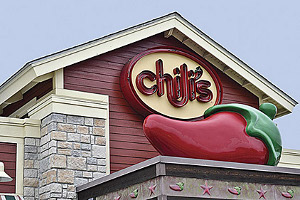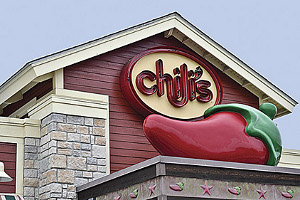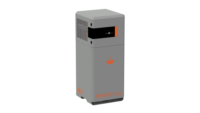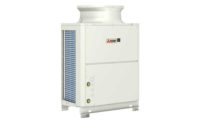Hot water is the lifeblood of any restaurant kitchen operation. Lacking a sufficient and ready supply at the correct temperatures, as prescribed by local health authorities, facility management usually has no choice but to lock the doors until the problem is fixed.
But despite the vital importance of hot water, getting the right quantities to right outlets at the right temperatures — especially during operational peaks — is an anxious, uphill battle for many managers. Whether the culprit is undersized equipment, poor installation, or inadequate maintenance, many restaurants routinely endure a tense, can’t-live-with-’em/can’t-live-without-’em relationship with their commercial water heaters.
Several and Smaller

|
|
This restaurant chain reported $1,800/yr savings at the first outlet retrofitted with a rack-mounted tankless water heating strategy. |
However, a relatively new and innovative approach to restaurant water heating that melds all of the necessary components into a single, prefabricated, ready-to-install package is achieving positive results for a growing number of proprietors, who have experienced improved system performance and longevity as well as energy savings.
Developed by Facilities Resource Group (FRG) of Grandville, MI, the innovation is an engineered rack system that combines one to six tankless water heaters from Noritz America with isolation valves, system and pump controllers, surge protectors, and even recirculation pumps and expansion tanks as needed — all mounted to a mobile aluminum frame and finished off with insulated copper tubing.
Since launching its comprehensive service in 2008, FRG has designed, built, and installed approximately 800 tankless water heater rack systems in 200 corporate and franchised restaurant locations nationwide. The company’s most prominent accounts include Texas Roadhouse Corporation (35 new facility installations and 160 retrofits) and Pepper Dining Inc. (PDI), which owns and operates 106 Chili’s facilities in 10 Northeastern states (38 retrofits).
“Restaurants put a heavy load on water-heating equipment, especially when they’re super-busy,” explains Benjamin C. Wirick, director of mechanical sales and engineering at FRG. In addition, the drive to maximize sales per square foot can result in a mechanical room that is simply too small to house the amount of hot-water storage the restaurant needs during its busiest times.
That explains the advantage of going tankless, which de-emphasizes gallons of storage in favor of Btu inputs. “Without the need for storage, we can pack a lot more Btu into the same small footprint,” Wirick says. “This enables the restaurant to manage its peak loads more easily at a lower operating cost.”
Meanwhile, that total Btu capacity is typically split among four, five, or six water heaters, which delivers two more important advantages: load-matching to cut energy costs and, even more important, the peace of mind that comes from unit redundancy.
The ability to gear energy consumption to present demand delivers substantial savings and efficiency. The NCC199 units have an input range of 11,000 to 199,900 Btuh. If a single hand-sink faucet is turned on, only one of the assembled tankless units in an FRG rack will activate. The modulating burner inside the unit will fire at the lower end of the Btu input range to meet the isolated need: Why use 199,990 Btu when 11,000 will do?
“But a conventional commercial water heater whose burner does not modulate will immediately ramp up to its full Btu capacity to deliver hot water to that one hand sink,” says Wirick. “This not only wastes energy but also stresses the equipment.”
Savings Realized
The 35 Chili’s restaurants in PDI’s territory that have gone tankless all use an FRG rack or wall-hung system with four units. Scott Amerault, director of facilities at PDI, conducted an informal survey of the very first installation in June 2010 and determined he was saving roughly $1,800 per year.
“But I haven’t done a formal, detailed energy analysis, because efficiency is not the driving force behind my company’s decision to go tankless,” he says. “We are even more enthusiastic about the reliability gained through multiple redundancies.”
As recently as early 2010, Amerault was closing down “what seemed like one restaurant weekly because of problems with the tank water heaters,” he recalls, adding that this was the case even when the restaurant used two tank units. “More often that not, the store still couldn’t get enough hot water. Maybe both units were down because the manager hadn’t noticed he was using the backup unit after the main one failed months ago.”
With four tankless water heaters, if one shuts down, Amerault’s operation still has nearly 600,000 Btu (199,900 x 3 units) at its disposal. Plus, fixing or replacing the down unit is also less expensive.
“If a tank-type heater fails on a Friday night, I’m hiring a plumber to work at double time to replace that tank immediately. Depending on its size, it could take two or even three guys to do that work. But if I lose a tankless heater on a Friday night, I just operate with the other three. I can wait until Monday for service, and it’s only one guy carrying a new unit in on his shoulder and working straight time for 90 minutes.”
“Restaurant managers are ‘laser-trained’ to use certain procedures on a consistent basis to minimize operational costs and maximize profits,” he continues. “We bring the same dedication to consistency in our work, applying good practices we develop in one restaurant or region across the United States.
“We are the eyes and ears of our customers, and we own their water-heating system from cradle to grave. We’re confident enough to say that any restaurant operator who has seen the FRG approach to installing and servicing water heaters will never go back to their old ways again.”Hot water is the lifeblood of any restaurant kitchen operation. Lacking a sufficient and ready supply at the correct temperatures, as prescribed by local health authorities, facility management usually has no choice but to lock the doors until the problem is fixed.
But despite the vital importance of hot water, getting the right quantities to right outlets at the right temperatures — especially during operational peaks — is an anxious, uphill battle for many managers. Whether the culprit is undersized equipment, poor installation, or inadequate maintenance, many restaurants routinely endure a tense, can’t-live-with-’em/can’t-live-without-’em relationship with their commercial water heaters.






